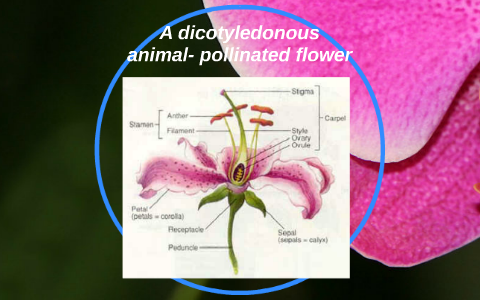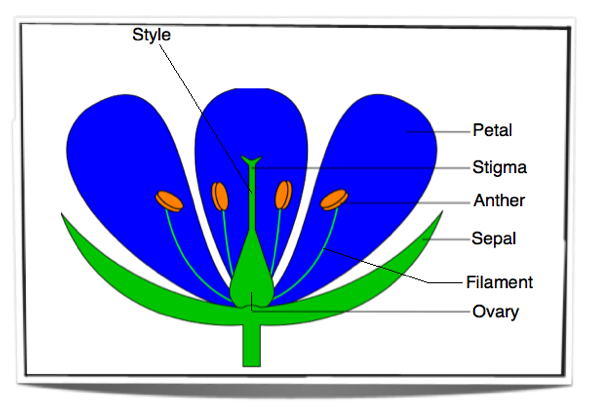Development of the seed and fruit Fruits aid seed dispersal The ovary wall becomes either a dry or. How do Dicots reproduce.

Why Are My Yellow Calla Lily Flowers Turning Green Home Alqu
Pollination - The process of.
. Draw and label a diagram showing the structure of a dicotyledonous animal-pollinated flower. Flowers need to be pollinated. Pollination is achieved through the use of the sensitive trigger which comprises the.
150 pounds of honey equals 13 round-trips to the moon. Diagram Distinguish between pollination fertilisation and seed dispersal. The transfer of pollen grains from the anther to the stigma usually of another plant often facilitated by animals wind or water movement.
A diagram showing the structure of a dicotyledonous animal pollinated flower Sepal petal anther filament stigma and ovary See Figure 1027 Clegg The Buttercup Flower Parts of the flower Sepals. 932 Distinguish between pollination fertilization and seed dispersal. Distinguish between pollination fertilization and seed dispersal.
Explain the conditions needed for the germination of a typical seed. The pollination syndromes of monocots can be quite distinct. Assessment Statements 931 Draw and label a diagram showing the structure of a dicotyledonous animal-pollinated flower.
Draw and label a diagram showing the external and internal structure of a named dicotyledonous seed. The stench of Bulbophyllum beccarii is so foul that it. Draw and label a diagram showing the external and internal structure of a named.
To study the body plan of a dicotyledonous plant. There are about 175000 known species of dicots. 941 Draw and label a diagram showing the structure of a dicotyledonous animal-pollinated flower.
There are a few flowers that can self-pollinate all on their own but this limits them to inbreeding. This dicotyledonous flower model is a great addition to any botany or general biology class. Dicots reproduce using flowers the way all angiosperms reproduce.
Distinguish between pollination fertilization and seed dispersal. The below mentioned article provides a practical exercise to observe the Body Plan of a Dicotyledonous Plant. The flower contains both the male and.
Transfer of pollen grains from anther to the stigma usually of another plant facilitated by animals wind or water movement. The flowers of orchids pollinated by flies or carrion beetles such as many of the Bulbophyllum species typically come in browns and fleshy reds and emit the odor of rotting meat. Ad 3B Scientific Supply For Science Medical Patient Education Today.
Most common garden plants shrubs and trees and broad-leafed flowering plants such as magnolias roses geraniums and hollyhocks are dicots. 2 anthers and the ovary are cut partly to show the inner structures of the dicotyledonous flower. Removable parts of the dicotyledonous flower are.
Draw and label a diagram showing the structure of a dicotyledonous animal-pollinated flower. They include having flower parts in multiples of three adaptations to pollination by water hydrogamy and pollination by sexual deception in orchids. Honey bees visit five million flowers to make one pint of honey.
931 Draw and label a diagram showing the structure of a dicotyledonous animal-pollinated flower. Collectively called the calyx Enclose the flower in the bud and are usually small green and leaf like Petals. 6 pollen grains that are mounted on the style can be easily identified.
Development of the seed and fruit Tissues of the ovary and sometimes the receptacle become the fruit. A complete small-sized herbaceous plant eg Brassica campestris or Solanum nigrum etc and a chart showing basic anatomical details of. Limit the diagram to sepal petal anther filament stigma style and ovary.
Dicots typically also have flower parts. Some crops including blueberries and cherries are 90 percent dependent on honey bee pollination. Draw and label a diagram showing the structure of a dicotyledonous animal-pollinated flower.
Stylidium also known as triggerplants or trigger plants is a genus of dicotyledonous plants that belong to the family StylidiaceaeThe genus name Stylidium is derived from the Greek στύλος or stylos column or pillar which refers to the distinctive reproductive structure that its flowers possess. Plant Sexual ReproductionSperm carried in the pollen from the male part of a flower fuses with the egg in the female part of the flower. Most species rely upon some kind of pollination vector to accomplish.
90 percent of the nations apple crop is pollinated by bees. Collectively called the corolla. Pollination is the process of moving the pollen grain from the anther of a stamen to the stigma of a carpel.
Dicotyledon byname dicot any member of the flowering plants or angiosperms that has a pair of leaves or cotyledons in the embryo of the seed. 932 Distinguish between pollination Hyperion Financial Management Readme - Oracle Hyperion Financial Managementâ - System 9 Release 931 Readme 3 Installation Components Financial Management 931 is a full. 931 - Structures of a dicotyledonous flower.
942 Distinguish between pollination fertilization and seed dispersal. Bees tend to prefer flowers that they can walk on to sip nectar.
9 3 Reproduction In Angiospermophytes Bioninja

Diagram Of A Dicotyledonous Animal Pollinated Flower By Merissa Jackson
9 3 Reproduction In Angiospermophytes Bioninja

Diagram Of A Dicotyledonous Animal Pollinated Flower By Merissa Jackson



0 comments
Post a Comment